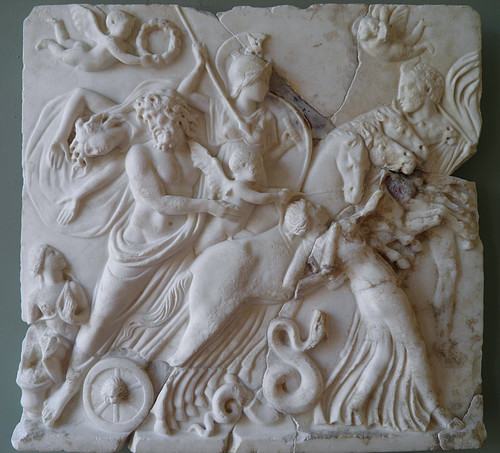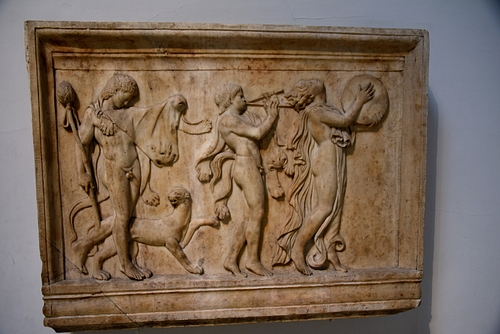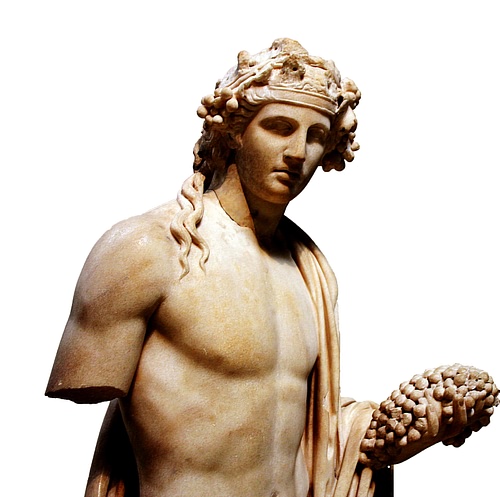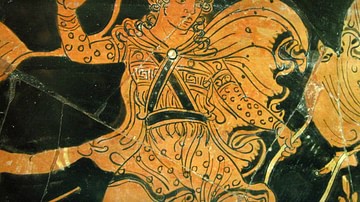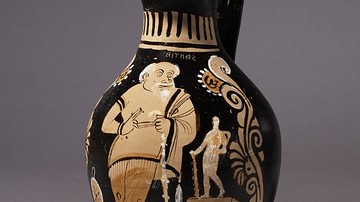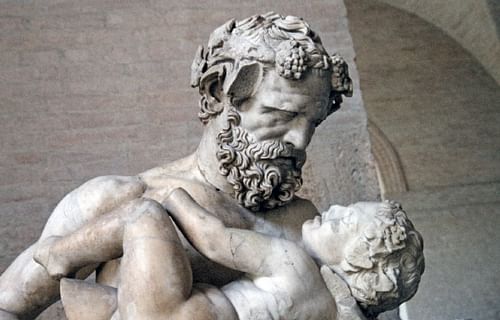
In ancient Greek mythology, Zagreus is a god closely associated with the wine god Dionysus, the underworld, and hunting. A son of Zeus and Persephone, he is known in the Orphic tradition as the first incarnation of Dionysus, whilst other stories identify him as the son of Hades or even as Hades himself.
The earliest mention of Zagreus comes from a quoted line from the lost Greek epic Alcmeonis, a poem dating back to at least the 6th century BCE, where he is described alongside Gaia, the Greek personification of the earth, as "highest of all the gods" (West, 61). Yet some scholars believe this line was only in reference to him being the highest of all the gods of the underworld, as surviving fragments of works written by the Greek tragedy playwright Aeschylus (c. 525 to c. 456 BCE) identify him closely with Hades.
Zagreus is also the name often given to Orphic Dionysus, whose story was central to the beliefs of the followers of Orphism. In the story, Zagreus, a child of Zeus and Persephone, was killed and eaten by the Titans, except for his heart which was found by Athena and brought to Zeus. Because his heart was saved, Zagreus was able to be reincarnated as the god Dionysus. Zeus punished the Titans for their treachery by destroying them with a thunderbolt, and it was from their ashes that humanity was born.
Followers of Orphism, therefore, believed that humanity had a dual nature, one of the body, inherited from the Titans, and one of the soul, or the divine spark inherited from the parts of Zagreus ingested by the Titans. It was the central focus of Orphism for one to achieve salvation through acts of atonement during their lifetime or else be cursed with endless reincarnation. Aspects of Orphism, including the suffering, death, and resurrection of Dionysus Zagreus, and the idea of redemption for an original sin call to mind aspects of later religions, such as Christianity.
Origins & Interpretations
What little is known of Zagreus outside his association with Dionysus comes from fragments of lost works of Greek literature. He was certainly renowned, as a surviving quote from the lost Greek epic Alcmeonis offers a prayer to "Mistress Earth, and Zagreus highest of all the gods" (West, 61). The invocation of his name alongside Mother Earth seems to suggest that Zagreus was held in high esteem and was thought to be very powerful. Some scholars believe that the reference to him as "highest of all the gods" does not claim that he was the greatest god on Mount Olympus, but rather that he was the greatest god of the underworld.
This can be gathered from the context of the prayer, in which the hero of the Alcmeonis, Alcmaon, calls upon the powers of the earth to see the soul of his father safely transferred to heaven. Zagreus' status as a god of the underworld can further be attested to by two works written by Aeschylus. One of these references, found in a fragmented line of one of Aeschylus' lost Sisyphus plays dating back to around the 5th century BCE, identifies Zagreus as the son of Hades. Another reference, from Aeschylus' Egyptians names Zagreus as Hades himself.
Either way, Zagreus seems to have been a powerful underworld god, earning the epithet "Chthonios," or "the subterranean." As for the associations of him to Dionysus, scholars such as Timothy Gantz have postulated that the separate myths of Zagreus, a son of Hades and Persephone, had over time become merged with the myth of Orphic Dionysus, the son of Zeus and Persephone, so that the name Zagreus came to be associated with both myths.
Association with Dionysus
Whether Zagreus and Dionysus were originally two separate deities or not, it is clear that the two did become closely linked over time. Hungarian scholar Károly Kerényi makes note of the word Sa-ke-re-u that appears as the name of a priest of Dionysus in Pylos. Kerényi says that the name could plausibly be rendered as Zagreus and that the priest of Dionysus could potentially have taken the name of the god. Kerényi further goes on to associate Zagreus with ritualistic hunting, specifically the sort found in the cult of Dionysus.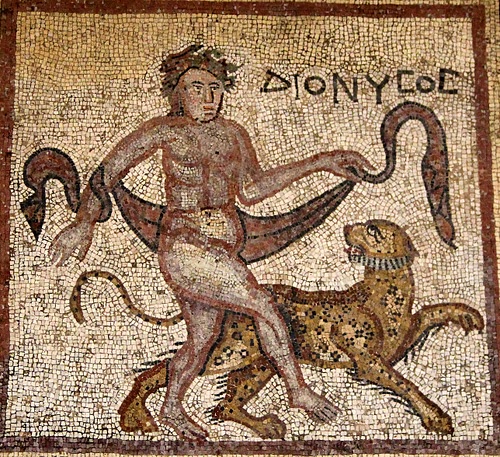
He mentions how in Greek the word zagreus is used to refer to a hunter who catches animals alive, whilst the Ionian word zagre signifies a "pit for the capture of live animals" (Kerényi, 82). Kerényi goes on to describe evidence of the Dionysus religion being prominent in Crete, where hunting was held in high regard, suggesting that it could have been there where the name Zagreus was bestowed upon the god of wine.
Yet Kerényi, acknowledging Zagreus' place as a god of the underworld who was also named for the act of capturing animals alive, wonders how these two traits fit together since it would seem contradictory for a god of the underworld to leave creatures alive. He notes the ritual observed by followers of Dionysus' religion, in which certain animals were "torn to pieces alive by the teeth of the participants and devoured raw" (Kerényi, 84). This act of dismembering and eating a living creature in an intoxicated frenzy is known in a Dionysian context as sparagmos. It is often associated with Dionysus, particularly with his mythical group of female followers known as the Maenads, or "raving ones," who often went into such murderous frenzies fueled by Dionysus' intoxication. It is also worth noting that Zagreus himself was said to have been dismembered and eaten alive by the Titans.
It is here that Zagreus' dual associations with capturing animals alive and with the realm of the dead may be reconciled. Because of the tendency of Dionysus Zagreus' followers to devour the animals alive, the god later retained such epithets as "Omestes" and "Omadios," which meant "eater of raw flesh."
The Orphic Myth of Dionysus Zagreus
The myth of Zagreus' birth, death, and resurrection as Dionysus, central to Orphism, can be found in the sixth book of the Dionysiaca. Written by the Greek poet Nonnus around the 5th century CE, the Dionysiaca, which tells of the life of Dionysus, is the longest surviving epic poem from Greco-Roman antiquity, standing at 48 total books and 20,426 lines.
As told by Nonnus, and elsewhere, the story of Zagreus begins when Persephone, wife of Hades, is seduced by Zeus, who has taken the form of a dragon. Persephone's mother, Demeter, had previously been warned about uninvited suitors in a prophecy, and, taking precaution, she hid Persephone away from in a cave. However, it was not enough to keep out Zeus, who appeared to Persephone in the form of a dragon. From their intercourse, the child Zagreus was born, and he was taken to the sacred Mount Ida by Zeus. Zeus took a liking to his newborn son and intended that Zagreus should eventually be the one to succeed him as king of the gods and the universe. Nonnus describes the seduction of Persephone and the birth of Zagreus as such:
By this marriage with the heavenly dragon, the womb of Persephone swelled with living fruit, and she bore Zagreus the horned baby, who by himself climbed upon the heavenly throne of Zeus and brandished lightning in his little hand and, newly born, lifted and carried the thunderbolts in his tender fingers. (Nonnus, lines 155-168)
Of course, Zeus' affair with another woman stirred the jealousy of his wife Hera, who decided to have the child killed. She conspired with the Titans, the old enemies of the Olympian gods who had been cast out of power by Zeus himself. In some versions of the tale, the Titans distracted the infant Zagreus with toys, and in others, they snuck up on him whilst he was distracted by his own reflection in a mirror. In any case, the Titans, their faces whitened by chalk, attacked the child, mutilating and killing him before eating bits of his flesh. Some accounts say that the Titans boiled the flesh in a cauldron, others that it was roasted over a fire. When Zeus learned of the murder of his son, his rage was fierce and swift. According to Nonnus:
After the first Dionysos had been slaughtered, Father Zeus learnt the trick of the mirror with its reflected image. He attacked the mother of the Titans with avenging brand, and shut up the murderers of horned Dionysos within the gate of Tartaros: the trees blazed, the hair of suffering Earth was scorched with heat. He kindled the East: the dawnlands of Bactria blazed under blazing bolts, the Assyrian waves set afire the neighbouring Caspian Sea and the Indian mountains, the Red Sea rolled billows of flame and warmed Arabian Nereus. (Nonnus, lines 206-224)
The Titans had not eaten Zagreus' heart, which was found by Athena and taken to her father Zeus. Zeus then swallowed the heart shortly before impregnating Semele, from whom Dionysus was born again. The Titans were then further punished by Zeus, and were destroyed with his lightning bolt, which reduced them to nothing but ashes. It was from these ashes that humanity was born. From this birth, humanity was given a dual nature: a body, evil and with a tendency to sin, that sprung from the Titans, but also a soul that is pure and divine, stemming from the pieces of the little god's body the Titans had eaten. It should be noted that the birth of mankind from the Titans is not found in the works of Nonnus.
Orphism & the Dionysian Mysteries
Orphism has been thought to have originated in at least the 6th century BCE and was practiced by Greeks across the Hellenistic world and by Thracians. It is thought to have been a later reform of the Dionysian religion, to which it is closely related. Whilst the earlier cult of Dionysus placed emphasis on liberation of the self from cultural inhibitions and societal constraints in order to return to a natural state, Orphism focused more on the idea of death, specifically the redemption of the soul. Because of this fixation with death and the underworld, it is fitting that the name orphism is derived from Orpheus, who descended into the underworld and returned.
In Greek mythology, Orpheus was a poet famous for his musical ability; it was said that his skill in song and playing the lyre was so great that he could "set rocks and trees in motion by his singing" (Apollodorus, 1.3). Yet, he is also famously associated with the underworld. When his wife, Eurydice, died from a snake bite, a grief-ridden Orpheus followed her into the underworld in an attempt to get her back. He managed to find Hades and Persephone, the rulers of the underworld, and move them with his miraculous music.
Hades agreed to let him take Eurydice back to the land of the living, on the condition that he not look at her, under any condition, until they were both safely out of the underworld. The singer and his wife almost made it to the surface of the ground when Orpheus, overcome with love (and doubt over whether Hades had kept his word), snuck a glance at his wife. This resulted in her ghost being dragged back down to the realm of Hades forever. Orpheus would later meet his own fate when he was torn to pieces by Dionysus' Maenads.
Although his existence has been doubted even by ancient Greek writers such as Herodotus, Orphic tradition states that it was Orpheus himself who penned the Dionysian mysteries. These were the rituals associated with Dionysus' cult, in which participants would induce some sort of trance, either through intoxicants or by music and dance. Not much is known about the mysteries since the uninitiated were barred from observing them and the initiated were forbidden from talking about them. The rites themselves were heavily associated with wine and wild Greek dance, with participants searching for the god Dionysus within themselves, of which they hoped to be filled by his spirit and powers. The mysteries, as with the cult itself, became popular throughout Greece, with a variation of it appearing in ancient Rome c. 200 BCE, known there as Bacchanalia.
From this came Orphism, which looked not only to find the divine spark of Dionysus within each person but to save that spark, or soul, from an endless cycle of reincarnation brought on by the original sin of the Titans. One could achieve this by living an ascetic, pure lifestyle and avoiding spiritual contamination, alongside various purification rituals. If one were to fail in this endeavor or be otherwise uninitiated, their souls would be reincarnated. If one were to achieve the purification of the soul, they would be permitted to move on to the afterlife.
Like the movement itself, not much is known about Orphic views on the afterlife. Some gold leaf tablets found in graves from Thurii, Hipponium, Thessaly, and Crete, however, contain instructions left for the dead to follow. These instructions warn the newly deceased of obstacles they will encounter on their way to the underworld, specifically warning them not to drink from Lethe, the river of forgetfulness, but instead of the pool of memory, Mnemosyne. The tablets also leave instructions on how to address the gods of the underworld: "Now you have died and now you have come into being, O thrice happy one, on this same day. Tell Persephone that the Bacchic One himself released you" (Graf, 37).
Aside from these tablets and the archaeological discovery of the Derveni Papyrus, not many primary texts survive discussing Orphic beliefs. However, the Orphic Hymns, a set of 87 poems composed in the 2nd or 3rd century CE does make reference to their beliefs, specifically of Zagreus parentage:
Liknitan Bacchus [Liknitos Dionysos], bearer of the vine, thee I invoke to bless these rites divine:
Florid and gay, of nymphs the blossom bright, and of fair Venus [Aphrodite], Goddess of delight,
'Tis thine mad footsteps with mad nymphs to beat, dancing thro' groves with lightly leaping feet:
From Jove's [Zeus'] high counsels nurst by Proserpine [Persephone],
and born the dread of all the pow'rs divine:
Come, blessed pow'r, regard thy suppliant's voice, propitious come, and in these rites rejoice. (Orphic Hymns, #45)
Other Interpretations of the Zagreus Myth
The Orphic beliefs found in the myth of Zagreus, specifically the details surrounding the birth of Dionysus himself and the origins of humanity, differ from stories on the same topics found elsewhere in Greek literature, such as in Hesiod's Theogony. This, combined with the similarities between the ideas of resurrection and the redemption of the soul found in Orphism with those same themes in Christianity, have caused some scholars to believe that the Zagreus myth, and even Orphic beliefs as a whole, have been misinterpreted by more modern scholars looking back and analyzing such myths through a Christianized lens.
This idea is furthered by the notion that Nonnus, who records the most detailed account of Zagreus' death and rebirth, does not mention the birth of humanity from the ashes of the Titans, a central part of Orphic belief. This integral part of the myth is explicitly mentioned only by Olympiodorus the Younger, writing in the 6th century CE. This argument can be balanced by looking at the works of ancient Greek writers such as Pindar, Plato, and Xenocrates who do make allusions to the myth, if not outrightly retelling it.
Zagreus also parallels the ancient Egyptian god Osiris. Like Zagreus, Osiris was a god of the underworld who was killed by a jealous relative and brought back to life. Another interpretation of the Dionysus Zagreus myth comes from Diodorus Siculus, who reports an allegorical interpretation that compares the dismemberment of Dionysus Zagreus with the production of wine.
There is not much known about Zagreus, or the myths, cults, and religious rituals surrounding him. Whether he was originally the son of Hades or another name for Hades himself, as Aeschylus suggests, or the first incarnation of Dionysus as found in Orphic belief, will be difficult to determine due to the lost nature of most of the early texts mentioning him and due to the secrecy of Dionysian and Orphic rituals.

